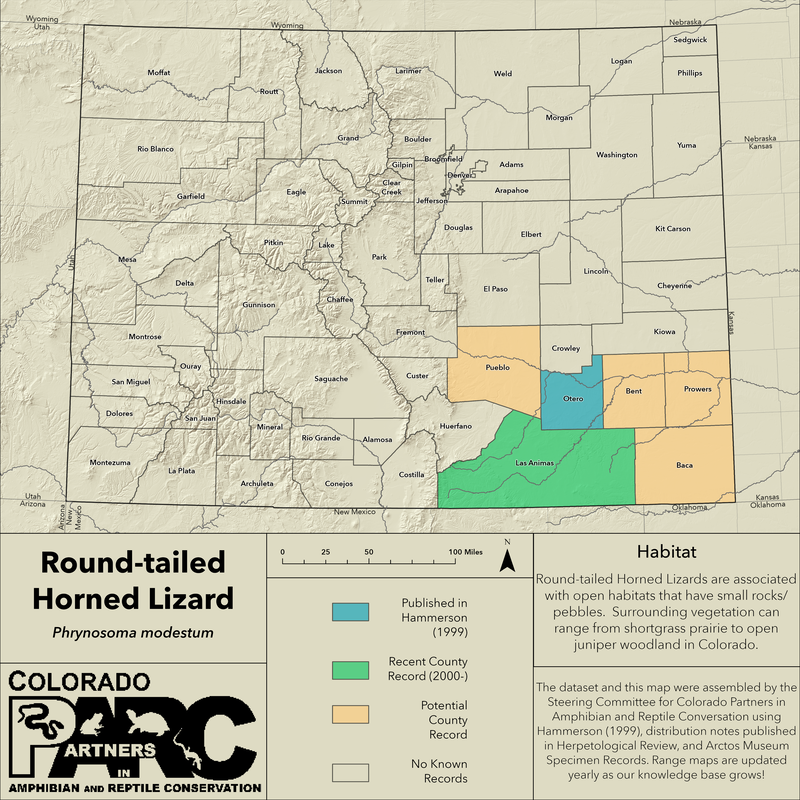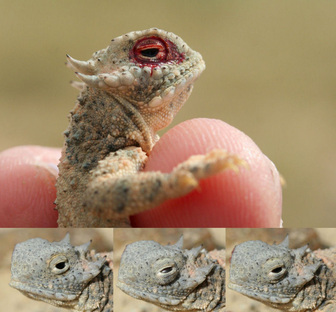round-tailed horned lizardPhrynosoma modestum
|
General Distribution: Round-tailed Horned Lizards are found in the southern Great Plains and Chihuahuan Desert (Hodges 2009). Their range extends from southeastern Colorado, extreme western Oklahoma (although see Martin & Leavitt 2012), western/central/southern Texas, southern/central/eastern New Mexico, to southeastern Arizona in the U.S. To the south the species’ range extends to central Mexico (Sherbrooke 2003). The Round-tailed Horned Lizard appears to occur in disjunct, apparently isolated populations through many parts of their range, and is often locally sympatric with the Texas Horned Lizard (Phrynosoma cornutum).
Colorado Distribution: Round-tailed Horned Lizards are only known from two sites in Colorado, representing the northernmost populations of this species. Both sites of known occurrence in Colorado are on privately-owned lands. In Otero County, they are found in rocky alluvium soils, while in Las Animas County they are found in broken plateau country (Rondeau 2002, Romotnik 1998, Martin unpublished data). This species may occur in similar habitats in Otero, Las Animas, Bent, and Baca Counties - likely in localized, disjunct populations.
Colorado Distribution: Round-tailed Horned Lizards are only known from two sites in Colorado, representing the northernmost populations of this species. Both sites of known occurrence in Colorado are on privately-owned lands. In Otero County, they are found in rocky alluvium soils, while in Las Animas County they are found in broken plateau country (Rondeau 2002, Romotnik 1998, Martin unpublished data). This species may occur in similar habitats in Otero, Las Animas, Bent, and Baca Counties - likely in localized, disjunct populations.
Conservation Status: Designated as a Non-game Species in Colorado. A Scientific Collection Permit from Colorado Parks & Wildlife is required to capture or handle this species (see State of Colorado regulations here). NatureServe rank: G5 (Globally Secure), S1 (State Critically Imperiled). General threats to conservation include habitat loss and fragmentation, and vehicle traffic on and off road. This species may be vulnerable to illegal collection – most of southeastern Colorado is privately-owned rangeland, and this may serve to better protect this species from potential collectors. If you find yourself with a horned lizard (e.g., your child brings one home or you unknowingly purchase this species), please contact Colorado Parks & Wildlife. Do not release unwanted captive animals, as they may harbor undetected pathogens that could cause disease in native wild populations. There is evidence that horned lizards are obligate brumators (hibernators), and do not survive long in captivity.
Diagnostic Features
- Dorso-ventrally flattened body (like a pancake) with round (cross-section) tail.
- Four equi-length, equi-distant spaced horns on back of head; short rough spines on dorsum (like rough sandpaper) relative to both the Short-horned and Texas Horned Lizard.
- No lateral fringe scales (compare with 1 row in Short-horned Lizard, 2 rows in Texas Horned Lizard).
- Males often have enlarged post-anal scales. Adult males have rust-colored femoral pores.
Coloration / Markings
- Varied, typically matching general color of area rocks and soil. This species’ color can vary both within a local site and among regional populations.
- No mid-dorsal stripe.
- Banded striping on tail.
- Pattern variations are similar between sexes and among age-classes.
- Individuals found to date in southeastern Colorado tend to range from tan/brown to rusty orange.
- Darker shades near the base of the neck, tail, and legs are thought to resemble shading at the base of pebbles, effectively making the species a ‘rock mimic’ (see Defenses from Predation below for more).
Size: Round-tailed Horned Lizards are reported to be sexually mature at just over 40 mm (1.57 in) Snout-to-Vent Length (SVL; Howard 1974), with maximum SVL of 66 mm in males and 71 mm in females (Fitch 1981). Hatchlings are reported as 21-30 mm SVL in New Mexico (Degenhardt et al. 1996). This is one of the smaller species of horned lizard based on maximum reported sizes.
Habitat: Round-tailed Horned Lizards are associated with somewhat open habitats that have small rocks/pebbles. Surrounding vegetation can range from shortgrass prairie to open juniper woodland in Colorado. They can be found at elevations between 900 and 2,200 m (2,953 to 7,218 ft) in New Mexico (Degenhardt et al. 1996), and the sites of known occurrence in Colorado are approximately 1,340 and 1,530 m (4,415 and 5,012 ft) elevation (D. Martin, personal observation).
Activity: Similar to related species, Round-tailed Horned Lizards are primarily diurnal from April to September. They are not typically active while brumating (hibernating) during the remainder of the year.
Reproduction: Mating likely occurs in spring or early summer in this species. Eggs are laid between May and July (Howard 1974, Pianka & Parker 1975), and hatchlings emerge between July and August (Howard 1974, Pianka & Parker 1975, Degenhardt et al. 1996). One hatchling was found by L. E. R. Martin in Otero County, Colorado, on 14 August and had a SVL of 27 mm and mass of 1.4 g (D. Martin, unpublished data); this individual may have been several weeks old (see photo page to see this individual).
Feeding & Diet: Primarily insectivorous. A major component of their diet is ants (Montanucci 1989), and they relied particularly on Honey Pot Ants (Myrmecocystus spp.) at a site in New Mexico (Shaffer & Whitford 1981). Similar to other horned lizards, this species is largely a sit-and-wait predator.
|
Defenses from Predation: Round-tailed Horned Lizards are highly cryptic both in behavior and coloration – this serves as a primary defense against predation. When discovered, they may flee for cover or stand their ground. They may arch remain still, with legs tucked close to the body, head down, and back arched in a ‘pebble-mimic’ pose, although in one experiment this was not found to be associated with presence of a nearby human (Cooper & Sherbrooke 2012). In some cases, they will eject blood from their orbital sinus (the corner of the eye), effectively squirting blood at a predator – this behavior was first documented for this species at the Otero County Colorado site (Wojnowski et al. 2010).
|
Cited & Additional Resources
Colorado Parks and Wildlife. Roundtail Horned Lizard. Natural Diversity Information Source. http://ndis.nrel.colostate.edu/wildlifespx.asp?SpCode=031301 [accessed Jan. 2015].
Cooper, W. E., Jr., and W. C. Sherbrooke. 2012. Choosing between a rock and a hard place: camouflage in the Round-tailed Horned Lizard. Current Zoology 58:541-548.
Degenhardt, W. G., C. W. Painter, and A. H. Price. 1996. Amphibians and reptiles of New Mexico. University of New Mexico Press, Albuquerque, New Mexico. 431 pp.
Hammerson, G. A. 1999. Amphibians and reptiles in Colorado. 2nd ed. University Press of Colorado, Boulder, Colorado. 484 pp.
Hodges, W. L. 2009. Round-tailed Horned Lizard. Pages 186–189 in L. L. C. Jones and R. E. Lovich, eds. Lizards of the American Southwest. Rio Nuevo Publishers, Tucson, Arizona. 567 pp.
Martin, D. 2009. Guide to the Horned Lizards of Colorado (brochure, 2nd ed.). Colorado Parks & Wildlife.
Martin, D. J., and D. J. Leavitt. 2012. Phrynosoma modestum: Geographic Range. Herpetological Review 43:103.
Montanucci, R. R. 1989. The relationship of morphology to diet in the horned lizard genus Phrynosoma. Herpetologica 45:208–216.
Rondeau, R. 2002. Phrynosoma modestum (Round-tailed Horned Lizard) Geographic Distribution. Herpetological Review 33:226.
Shaffer, D. T., and W. G. Whitford. 1981. Behavioral responses of a predator, the Round-tailed Horned Lizard, and its prey, Honey Pot Ants. American Midland Naturalist 105:209-216.
Sherbrooke, W. C. 2003. Introduction to the horned lizards of North America. University of California Press, Berkeley and Los Angeles, California. 191 pp.
Wojnowski, D., D. J. Martin, and L. E. Rosen. 2010. Phrynosoma modestum: Blood-squirting. Herpetological Review 41:228.
Cooper, W. E., Jr., and W. C. Sherbrooke. 2012. Choosing between a rock and a hard place: camouflage in the Round-tailed Horned Lizard. Current Zoology 58:541-548.
Degenhardt, W. G., C. W. Painter, and A. H. Price. 1996. Amphibians and reptiles of New Mexico. University of New Mexico Press, Albuquerque, New Mexico. 431 pp.
Hammerson, G. A. 1999. Amphibians and reptiles in Colorado. 2nd ed. University Press of Colorado, Boulder, Colorado. 484 pp.
Hodges, W. L. 2009. Round-tailed Horned Lizard. Pages 186–189 in L. L. C. Jones and R. E. Lovich, eds. Lizards of the American Southwest. Rio Nuevo Publishers, Tucson, Arizona. 567 pp.
Martin, D. 2009. Guide to the Horned Lizards of Colorado (brochure, 2nd ed.). Colorado Parks & Wildlife.
Martin, D. J., and D. J. Leavitt. 2012. Phrynosoma modestum: Geographic Range. Herpetological Review 43:103.
Montanucci, R. R. 1989. The relationship of morphology to diet in the horned lizard genus Phrynosoma. Herpetologica 45:208–216.
Rondeau, R. 2002. Phrynosoma modestum (Round-tailed Horned Lizard) Geographic Distribution. Herpetological Review 33:226.
Shaffer, D. T., and W. G. Whitford. 1981. Behavioral responses of a predator, the Round-tailed Horned Lizard, and its prey, Honey Pot Ants. American Midland Naturalist 105:209-216.
Sherbrooke, W. C. 2003. Introduction to the horned lizards of North America. University of California Press, Berkeley and Los Angeles, California. 191 pp.
Wojnowski, D., D. J. Martin, and L. E. Rosen. 2010. Phrynosoma modestum: Blood-squirting. Herpetological Review 41:228.
Account compiled by: Daniel (Danny) Martin
Reviewed by: Ben Fisher (text)
Last updated: 4/14/2022 by Rémi Pattyn
Reviewed by: Ben Fisher (text)
Last updated: 4/14/2022 by Rémi Pattyn
Suggested Citation
Colorado Partners in Amphibian and Reptile Conservation. 2015. Species account for Round-tailed Horned Lizard (Phrynosoma modestum). Compiled by Danny Martin. http://www.coparc.org/round-tailed-horned-lizard.html [accessed date here]. Editor: Ben Fisher.
Colorado Partners in Amphibian and Reptile Conservation. 2015. Species account for Round-tailed Horned Lizard (Phrynosoma modestum). Compiled by Danny Martin. http://www.coparc.org/round-tailed-horned-lizard.html [accessed date here]. Editor: Ben Fisher.



